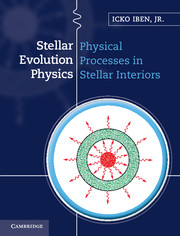Book contents
- Frontmatter
- Contents
- Preface
- Part I Introduction and overview
- Part II Basic physical processes in stellar interiors
- 3 Properties of and physical processes in main sequence stars–order of magnitude estimates
- 4 Statistical mechanics, thermodynamics, and equations of state
- 5 Polytropes and single zone models
- 6 Hydrogen-burning reactions and energy-generation rates
- 7 Photon–matter interaction probabilities, absorption cross sections, and opacity
- 8 Equations of stellar evolution and methods of solution
- Part III Pre-main sequence, main sequence, and shell hydrogen-burning evolution of single stars
- Index
- References
6 - Hydrogen-burning reactions and energy-generation rates
from Part II - Basic physical processes in stellar interiors
Published online by Cambridge University Press: 05 December 2012
- Frontmatter
- Contents
- Preface
- Part I Introduction and overview
- Part II Basic physical processes in stellar interiors
- 3 Properties of and physical processes in main sequence stars–order of magnitude estimates
- 4 Statistical mechanics, thermodynamics, and equations of state
- 5 Polytropes and single zone models
- 6 Hydrogen-burning reactions and energy-generation rates
- 7 Photon–matter interaction probabilities, absorption cross sections, and opacity
- 8 Equations of stellar evolution and methods of solution
- Part III Pre-main sequence, main sequence, and shell hydrogen-burning evolution of single stars
- Index
- References
Summary
Stars spend most of their nuclear burning lives on the main sequence converting hydrogen into helium in central regions. After leaving the main sequence, single stars and stars in wide binaries continue to burn hydrogen in a shell as helium is converted into carbon and oxygen in the hydrogen-exhausted core. The lifetime of a star in the core helium-burning phase, which in intermediate mass stars is typically 10–30% of the main sequence lifetime, is determined by the rate of helium burning, but hydrogen-burning reactions contribute most of the light emitted by the star. The time spent in more advanced stages of nuclear burning is quite small compared with that spent during the main hydrogen- and helium-burning phases. Thus, over most of a star's nuclear burning lifetime, hydrogen-burning reactions are the major contributors to the stellar luminosity.
In population I stars of mass smaller than ˜2 M☉, the reactions which dominate energy production during the main sequence phase are those in the so-called pp chains, which are initiated by the transformation of two protons into a deuterium nucleus. The reactions which follow this initial pp-chain reaction terminate with the formation of 3He (at low temperatures) or with the formation of 4He (at higher temperatures). These subsequent reactions release considerably more energy than is released in the pp reaction itself, but the overall rate of energy release is nevertheless controlled by the pp reaction since it is, by far, the slowest reaction in the chains.
- Type
- Chapter
- Information
- Stellar Evolution Physics , pp. 258 - 297Publisher: Cambridge University PressPrint publication year: 2012



